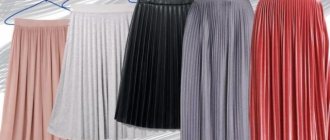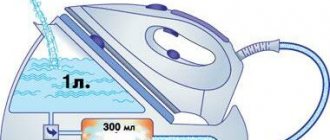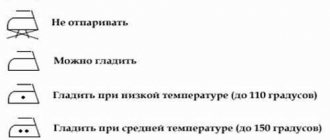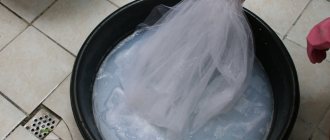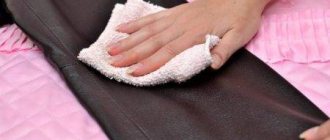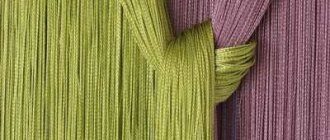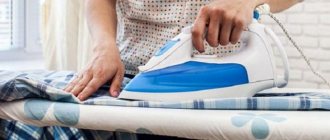0 /5
13.11.2021
294
Curtains are an irreplaceable product, without which the interior of an apartment or house will look inharmonious and incomplete. They give the room coziness and also allow you to regulate the degree of illumination in it. Caring for curtains often raises difficulties and questions, which especially relate to ironing them, because many people believe that ironing them is completely unnecessary or even impossible. Let's take a closer look in the article on how to iron curtains and which of them should not be subjected to heat treatment.
Is it possible to iron curtains after washing?
answer to the question, is it possible to iron curtains - of course. In addition, this should be done almost always. Even with careful washing and drying, creases and folds will form on the fabric in any case, which will spoil the appearance of the entire interior.
To be more precise, curtains made from the following materials and fabrics are ironed and steamed:
Chiffon Organza Cotton Linen Viscose Polyester Lycra Fabrics Silk Taffeta Voile Velvet
Both natural fabrics and synthetic or artificial fabrics can be ironed. In this case, it practically does not matter whether they have a relief ornament on them or not.
Some curtains do not need to be ironed at all; you just need to carefully dry them naturally, and they will straighten out on their own under their own weight. Typically these include products made from dense and heavy fabrics:
Chenille Nylon Linen Taffeta
Helpful information
To perfectly smooth the tulle after washing, it is necessary that the washing be done correctly. What is meant? A few highlights:
- Temperature up to 30°C to prevent yellowing of the fabric.
- It is best to wash by hand.
- Before washing the curtains, shake well to get rid of at least some of the dust.
- If the tulle is heavily soiled, you can soak it in soapy water for 12 hours.
- When washing by hand, just squeeze and turn the fabric.
- To avoid creases, avoid strong friction and wringing.
The washed tulle is dried in the open air. If this is not possible, you can attach it to the cornice, allowing it to straighten out under its own weight.
How to smooth out wrinkles without removing the curtains from the curtain rod?
Ironing curtains using an ironing board or a vertical steam generator stand is quite difficult, since the fabric has to be constantly adjusted and rehanged during processing. Often the parts that have already been ironed begin to wrinkle again at this time, and the duration of ironing increases. Because of this, many housewives prefer to iron directly on the cornice.
To smooth the fabric without using an iron, steamer or steam generator, follow the recommendations:
Hang curtains almost immediately after washing on a curtain rod. By straightening them while still wet, the likelihood that they will dry evenly is much higher. To prevent dripping water from getting onto the floor, you can lay towels underneath.
Use a steamer or iron with a steam setting. Do not bring the device too close to the fabric to avoid damaging it.
Place a container of boiling water under the curtains. The essence of the method is similar to steaming, but it happens naturally.
Large creases can be removed with a solution of table or apple cider vinegar and fabric softener, mixed in equal proportions. The resulting solution is poured into a spray bottle and then distributed over the dented areas. As the canvas dries, it will become smooth and there will be no marks left on it.
Before ironing hanging curtains, pay attention to the type of fabric from which they are made. In this regard, it is easier to work with dense textiles, since they are smoothed out under their own weight. But thin and fancy fabrics require longer processing.
Steam without appliances
To iron curtains by weight, you do not necessarily need to use special equipment. You can use some knowledge. For example, you can remove all folds and wrinkles from the material by hanging wet curtains on a line in the bathroom, filling the bathtub with hot water and closing the door to the room.
About 20 minutes after the steam has exposed the fabric, all you have to do is hang the curtains directly on the curtain rod - they will stretch out and be even.
Important! If creases still remain, you can use steam from the kettle. Just boil water in it, place the spout directly under the crumpled fabric, hold for a minute or two, and that’s it - the curtains will be completely straightened.
How to wash curtains without ironing them?
In order not to even think about how to properly iron the curtains, you can simply follow the recommendations for washing them, which will reduce the wrinkleability of the material and make it more amenable to smoothing out on its own as it dries.
The rules are quite simple:
Wash curtains separately from other items. If you wash long and wide curtains consisting of several parts, it is better to divide them into several washes without completely filling the washing machine drum. Before machine washing, carefully fold the curtains into a linen bag for washing delicate fabrics. When washing by hand, first soak the item for 15-20 minutes with washing powder or gel, then rinse several times and hang in a vertical position to dry naturally. Do not twist or wring out the fabric.
Use a delicate wash cycle at a temperature of no more than 30-40°C (taking into account the composition and texture of the fabric).
Turn off the spin cycle completely when machine washing.
Instead of powder, use liquid washing gels, and also add conditioner to further soften the fabric.
After washing, immediately remove the curtains from the washing machine drum and hang them up. The wetter they are, the more likely it is that you won't have to iron them. Do not speed up the drying process by using additional light or heat sources.
Types of steamers
In everyday life, hand-held or floor-mounted steamers are used. They are pump-type or gravity-fed. There are devices designed only for steaming, and multifunctional devices.
Horizontal and vertical
Horizontal models are mainly designed for ironing and cleaning clothes. Vertical ones are used when working with curtains. With their help, you can iron curtains without removing them from the curtain rod, which simplifies and speeds up this process.
Manual
Such devices are small in size and weight, they look like a brush. They are convenient to use while traveling. The power of such senders is within 900 W, they have a small water tank, so the time of continuous operation without refueling is no more than 10-20 minutes.
Floor-standing
Floor-standing models have several operating modes, their power is 1.5 kW or more. With their help, it is convenient not only to iron curtains, but also to care for blinds and clothes.
The set includes a hanger on which it is convenient to place the product being processed. On one refill, such models can work for up to 2 hours.
Gravity
They have a simple design. After heating the water in the tank, steam is formed, which is supplied through the nozzle to the item being processed. The principle of operation of a gravity steamer can be compared to a simple kettle with steam escaping through the spout.
Pump-action
Such models work under pressure. After heating the water and generating steam, it is not immediately supplied to the nozzle, but is delayed by the valve in the steamer.
When the pressure reaches the set value, the valve opens and steam escapes. The advantage of this solution is that it is possible to smooth out products in hard-to-reach places. The disadvantage is that steam is supplied for 2 minutes, then you have to wait a little for the pressure to rise again.
Multifunctional steam generators
The peculiarity of such devices is that in addition to ironing clothes, they can operate in steam cleaner mode, then with its help you can perform other work:
- disinfection of clothes;
- cleaning different surfaces;
- elimination of unpleasant odors.
Criterias of choice
There are a number of characteristics that must be taken into account in order to choose the right steamer:
- Power. The strength of the steam created depends on it. If a device with a power of 900 W is sufficient for tulle, then for dense fabrics you need to choose models with a power of more than 1.5 kW.
- Tank volume. It affects the duration of continuous operation. To make ironing curtains convenient, the tank capacity should be 1-2 liters.
- Equipment. The presence of different attachments, as well as the ability to adjust the length of the rod, simplifies the work with such a device. Some steamer models allow you to add detergent to the water tank.
Basic mistakes when ironing
Due to the fact that there are many rules and recommendations for ironing curtains, not everyone takes them into account when caring for them. Because of this, the products lose their original appearance, stains appear on them, iron marks appear on them, or they simply do not smooth out.
The most common mistakes made are:
Drying curtains in a dryer. After this, many creases and marks appear on the product, which are difficult to smooth out in a completely dry state.- Untimely ironing. Even if you dried the curtains naturally, it will be useless when ironing them after they are completely dry. You need to iron slightly damp and under-dried curtains, then it will be easier to work with them, and you will be able to remove all the wrinkles.
- Strong ironing of seams. Even when ironing them from the wrong side through a layer of gauze, you need to lightly touch them with the iron, without pressing too much. Otherwise, marks from the seams will remain on the front side of the product.
- Using an iron with a dirty surface. Often the fabrics from which curtains are made are very vulnerable and difficult to care for, so they quickly get dirty and absorb dirt. Soot deposited on curtains from an iron can be difficult to wash off, and traces of it remain on the material forever.
- Steaming curtains made of any material. Despite the fact that this ironing method is considered quite delicate, it is not suitable for some fabrics and can only ruin them.
Before processing the curtains, be sure to pay attention to the recommendations for caring for them, which are written on the label from the manufacturer. This way you can maintain the condition of the product and avoid its damage.
Care instructions
Curtains, like any object, trap dust, tobacco smoke particles, animal hair, pollen and other contaminants.
If cleanliness in your home is important to you, then the curtains simply need to be cleaned from time to time.
- Airing curtains. This recommendation is the simplest and most effective way to keep curtains fresh. Open the window wide, draw the curtains and let them flutter in the wind for a few hours. The smell of dust that appears in the curtains over time will disappear. If you can carry out this procedure at least once every few weeks, your curtains will remain fresh and clean for a long time.
- Cleaning curtains with a vacuum cleaner. Curtains can be cleaned with a vacuum cleaner. Regular removal of dust is necessary to ensure that its particles do not eat into the fibers of the fabric, because once dust penetrates the structure of the fabric, it is not easy to remove. You need to clean curtains with a vacuum cleaner with a special soft brush attachment, paying special attention to their insides, folds and fringes.
- Steam treatment. To refresh your curtains, you can use a steam generator. But you should know that when cleaning with steam, only dust is removed from the surface of the curtains. Also, fabrics made from natural fibers and their mixtures should not be steam-treated.
- From time to time, take care of the curtain rod: spray a cleaner with an antistatic agent on the curtain rod itself and the top of the curtains - this will help prevent dust from accumulating, and in addition, the curtains themselves will move more easily. The curtain rod itself should be cleaned regularly using detergent and a soft brush. Pay special attention to the fasteners: rings and other small parts “love” to collect dust!
- Do not dry curtains in the sun. Direct exposure to sunlight on fabric can result in unsightly yellowing and loss of the primary color.
- When ordering curtains, immediately check with the seller or designer how to properly care for this type of fabric. Self-will when caring for curtains will result in loss of shape, color, burning of the fabric and other problems that you hardly need.
By following these simple rules and recommendations, you will keep your curtains in their original appearance. Treat your item with love and it will last you for years!
Question answer
What to do with rhinestones and voluminous decor on curtains?
Such products cannot be ironed either from the front or from the back, since the iron will in any case leave marks on the fabric from the decor. Use a steamer or steam generator at low temperature, especially if rhinestones are attached with glue.
Is it possible to wash several types of curtains together?
No, it is not recommended to fill the washing machine drum completely with curtains, otherwise they will wrinkle more and will be more difficult to iron.
Which curtains cannot be steamed?
Steam is not recommended for processing thin, light and translucent fabrics - organza, tulle, nylon, as well as materials made from artificial fibers - viscose and polyester, otherwise they may ripple or form marks and stains from moisture.
How to iron long and heavy curtains without wrinkles again?
Ironing should be done near a window. Place the top of the curtains on the ironing board and gradually iron it, hanging the processed part from the back of the board. When the fabric touches the floor, hang it on the curtain rod so that the crumpled bottom part just rests on the ironing board. Iron the curtains completely.
How to iron starched tulle
Before you start ironing the starched tulle, you need to wring out the curtains and dry them a little. You can’t twist them, just squeeze them well and shake them. Some housewives are afraid to iron tulle, so they hang it wet and it flattens out under its own weight.
If there is a need to smooth out bruises, do this with an iron heated to 120 °C. It is better to iron starched curtains that are not fully dried; if they dry out, it will no longer be possible to iron them.
To prevent the iron from sticking to the tulle, add gauze or cotton fabric. Steam cannot be used, otherwise the starch will lose its properties.
When choosing a steamer, you must know for what purpose it is being purchased. If you take the device on trips, it is better to buy a manual model.
It is recommended to purchase floor-mounted steamers for your home or office. A universal option is a steam generator. With its help, you can not only smooth clothes and curtains, but also clean and disinfect various surfaces.
Fabrics that do not need to be ironed
It is not possible to avoid ironing curtains in all cases. Some types of fabrics are not prone to self-expanding and require mandatory heat treatment. But many materials can do without ironing and still look decent.
Such materials include:
- chiffon;
- organza;
- blackout and some other types.
Proper washing avoids ironing. To avoid ironing curtains, they should only be washed by hand.
The washing process should proceed as follows:
The curtains are removed from the cornice.- Warm water is drawn into the bath.
- Dilute a suitable detergent in water.
- The curtain is carefully lowered into the water.
- If the fabric is organza, silk or chiffon, then you need to wash the curtain immediately. For other materials, a short soaking of a quarter of an hour is possible.
- Wash delicate fabrics without intense physical impact using stroking movements.
- Rinse several times in clean water (cool or slightly warm).
- The curtain is taken out of the bath without squeezing it out.
- Hang the curtain in a free state. At the same time, place a container to drain the water.
- Straighten the fabric with your hands.
- After the water has drained, the curtains are hung in their permanent place while still wet.
Tricks for large canvases
When buying tulle, we imagine how impressive it will look on the window. At the same time, we don’t think much about how to take care of this “colossus” of such size. Washing is no problem, I threw it in the machine and chose the “hand” or “delicate” wash mode. In 20-30 minutes everything is ready. But when you imagine how much you will have to iron this “wet cloud”, any desire to even wash it disappears.
To quickly iron large tulle, you need to iron the top and then attach it to the cornice. The ironing board should be as close to the window as possible. When the top half is already hanging, iron the hanging wrinkled part. The method is quite fast, and the result is high quality.
A large curtain can be hung over a bathtub filled with hot water. Steaming time is about half an hour. Then straighten it with your hands, hang it, and let it dry.
Lambrequin: the most complex element
Lambrequin is an elegant decorative drapery that is attached to the top of the curtain composition . For the most part, this decoration of a window opening is made from the same fabric as the curtain.
The shape of the lambrequin can be very different, most often with a large number of folds.
Some lambrequins cannot be washed; they are cleaned by steaming or sent to dry cleaning.
The complex shape of the drapery is almost impossible to straighten with an iron . Steaming comes to the rescue.
For lambrequins without fixed draperies, the same ironing is possible as for the curtains themselves. Lambrequins on a rigid base are treated only with steam or dry-cleaned.

